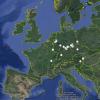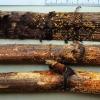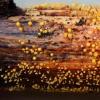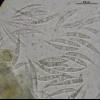
28-12-2025 12:08
Margot en Geert VullingsThis possible Karstenia was found on the bark of d

21-12-2025 21:32
Pol DebaenstHello, Garden, Burgweg 19, Veurne, BelgiumOn 10/1

26-12-2025 21:19
Arnold BüschlenPithyella chalaudii Priou. Ist als Bryoparasit in

21-12-2025 09:32
Hello.A tiny ascomycete found embedded in wood in

18-12-2025 21:17
Pol DebaenstThe identification took me to Byssonectria deformi

24-12-2025 17:08
Hulda Caroline HolteHello, I have found this propoloid ascomycete on
Hymenoscyphus sachalinensis in southern Germany
Hans-Otto Baral,
21-08-2017 21:19
 Hi all
Hi allyesterday I finally found in my home village in Tübingen Hymenoscyphus sachalinensis alias H. aff. dearnessii in masses, it is my first personal collection. I did not expect that because over all the years I never saw it, although looking now and then on its substrate, dead stems of Reynoutria sachalinensis (or R. x bohemica, rarely R. japonica).
Here I add the most actual map of the (still not validly described) species, where you can see that large areas are without a record, to my knowledge. In case you have collected it in such an "empty" area, please do not hesitate and contact me.
The species is very frequent in the middle of Germany, and now I assume that it can perhaps be found all over central Europe. Certainly it is invasive, the question is only at what time it arrived at which place. The first known collections were made as late as 2001.
I also add some images of my collection. The species differs from H. scutula in the abundant growth of the bright yellow apothecia, distinctly longer spores (30-36) which are not really scutuloid because the asymmetry at the spore apex is lacking and therefore the upper setula inserted apically.
Zotto



